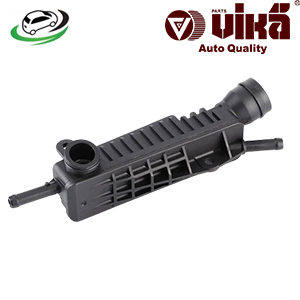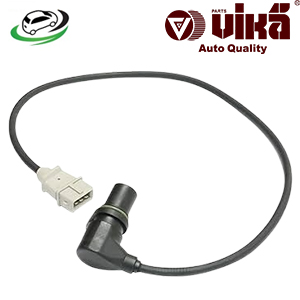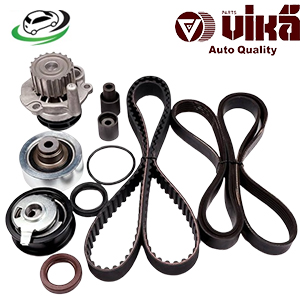-16%
Get Timing belt set VW Beetle 1.9L/Beetle Convertible 1.9L/Golf 1.9L/Jetta 1.9L/Jetta Wagon 1.9L 038109119M
The timing belt set is a crucial component in an internal combustion engine, playing a vital role in synchronizing the movement of the crankshaft and camshaft(s). This synchronization ensures that the engine’s valves open and close at the correct times during the intake and exhaust strokes, which is essential for proper engine operation. The timing belt set typically includes the timing belt itself, tensioners, pulleys, and sometimes a water pump. In this guide, we’ll explore the function, components, maintenance, replacement process, and common issues associated with the timing belt set.
1. Understanding the Timing Belt Set
a. Role of the Timing Belt:
The timing belt is responsible for coordinating the rotation of the crankshaft and camshaft(s). This ensures that the engine’s valves open and close in sync with the pistons, allowing the engine to run efficiently. The timing belt must be precise because even a small deviation can cause the engine to run poorly or, in the case of interference engines, lead to catastrophic engine damage.
b. Components of a Timing Belt Set:
- Timing Belt: The main component, typically made from rubber reinforced with fiberglass or Kevlar, which ensures durability and flexibility. The timing belt has teeth that match the gears on the camshaft(s) and crankshaft, ensuring synchronized rotation.
- Tensioner: Maintains the proper tension on the timing belt to prevent it from slipping or jumping teeth on the sprockets.
- Idler Pulley: Guides and supports the timing belt, ensuring it runs smoothly over the gears and pulleys.
- Water Pump (optional): In some timing belt sets, the water pump is driven by the timing belt. Replacing it during a timing belt change is often recommended, as it’s difficult to access.
c. Importance of the Timing Belt Set:
The timing belt set is crucial for maintaining the engine’s timing. Without it, the engine would not function correctly, leading to poor performance, increased emissions, and potential engine damage.
2. Function of the Timing Belt Set
a. Synchronizing Engine Components:
The primary function of the timing belt is to synchronize the rotation of the crankshaft and camshaft(s). The crankshaft controls the pistons’ movement, while the camshaft controls the opening and closing of the engine’s valves. The timing belt ensures that these components work together in harmony, allowing the engine to operate efficiently.
b. Ensuring Proper Valve Operation:
The timing belt controls when the engine’s valves open and close. The intake valves open to allow the air-fuel mixture into the cylinders, and the exhaust valves open to allow the exhaust gases to exit. The timing of these actions is crucial for the engine to run smoothly and efficiently.
c. Preventing Engine Damage:
In interference engines, if the timing belt fails, the pistons and valves can collide, causing severe engine damage. This makes the timing belt a critical component that must be maintained and replaced at the recommended intervals to avoid catastrophic engine failure.
3. Common Issues with the Timing Belt Set
a. Timing Belt Wear and Tear:
Over time, the timing belt can wear out due to the constant stress of synchronizing the engine components. Common signs of wear include:
- Cracking: Cracks can develop on the surface of the belt, especially if it is old or exposed to high temperatures.
- Tooth Wear: The teeth on the timing belt can wear down, leading to slippage or misalignment.
- Fraying: The edges of the belt can fray, indicating that it may be near the end of its service life.
b. Tensioner and Pulley Issues:
The tensioner and idler pulleys are also prone to wear. Common issues include:
- Bearing Failure: The bearings in the tensioner or idler pulley can wear out, leading to noise or misalignment.
- Improper Tension: If the tensioner fails, it can result in the timing belt being too loose or too tight, which can cause the belt to slip or wear prematurely.
c. Timing Belt Failure:
Timing belt failure is one of the most severe issues, as it can lead to engine damage, especially in interference engines. Signs of potential timing belt failure include:
- Engine Misfires: A slipping belt can cause the engine to misfire, as the timing of the valve operation is disrupted.
- Loss of Power: The engine may lose power if the timing belt is not functioning correctly.
- Unusual Noises: A ticking or slapping noise from the engine could indicate a loose or failing timing belt.
4. Replacing the Timing Belt Set: Step-by-Step Guide
a. Preparation:
Before starting the replacement process, gather the necessary tools and parts, including the timing belt set, which may include the belt, tensioner, idler pulleys, and water pump. Ensure the vehicle is parked on a level surface, and the engine is cool.
b. Accessing the Timing Belt:
- Step 1: Disconnect the battery to ensure safety.
- Step 2: Remove any components obstructing access to the timing belt cover, such as the engine cover, accessory belts, or other engine components.
- Step 3: Remove the timing belt cover to expose the timing belt and related components.
c. Aligning Timing Marks:
- Step 1: Rotate the engine by hand using a wrench on the crankshaft pulley bolt until the timing marks on the crankshaft and camshaft(s) align with the marks on the engine block. This ensures that the engine is at top dead center (TDC) on the compression stroke.
d. Removing the Old Timing Belt:
- Step 1: Loosen the tensioner to relieve tension on the timing belt.
- Step 2: Carefully remove the timing belt from the pulleys, ensuring that the timing marks remain aligned.
- Step 3: If the timing belt set includes a water pump, remove and replace the water pump at this time.
e. Installing the New Timing Belt:
- Step 1: Install the new tensioner and idler pulleys, if included in the timing belt set.
- Step 2: Carefully position the new timing belt on the pulleys, ensuring that the teeth of the belt engage properly with the gears.
- Step 3: Double-check that the timing marks are still aligned before applying tension to the belt.
- Step 4: Adjust the tensioner to apply the correct tension to the timing belt. The belt should be taut but not overly tight.
f. Reassembling the Engine:
- Step 1: Replace the timing belt cover and any components that were removed to access the belt.
- Step 2: Reinstall the accessory belts, engine cover, and other parts as necessary.
- Step 3: Reconnect the battery.
g. Final Checks:
- Step 1: Rotate the engine by hand again to ensure that the timing marks remain aligned after the new belt is installed.
- Step 2: Start the engine and listen for any unusual noises. The engine should run smoothly, and there should be no signs of misalignment or belt slippage.
5. Maintenance Tips for the Timing Belt Set
a. Regular Inspections:
Inspect the timing belt regularly for signs of wear or damage. If you notice any cracks, fraying, or other issues, replace the belt promptly.
b. Follow Manufacturer’s Recommendations:
Always follow the manufacturer’s recommended replacement intervals for the timing belt. These intervals are typically based on mileage or time, whichever comes first. Replacing the belt on schedule can prevent costly engine damage.
c. Replace Related Components:
When replacing the timing belt, it’s advisable to replace the tensioner, idler pulleys, and water pump (if driven by the timing belt) at the same time. These components are subject to wear and can cause the new belt to fail prematurely if not replaced.
d. Keep the Engine Cool:
Overheating can accelerate the wear of the timing belt. Ensure that the cooling system is functioning correctly and that the engine operates within the recommended temperature range.
e. Listen for Unusual Noises:
Pay attention to any unusual noises coming from the engine, such as ticking or slapping sounds. These could indicate a problem with the timing belt or related components.
Follow us on Facebook for more parts.



